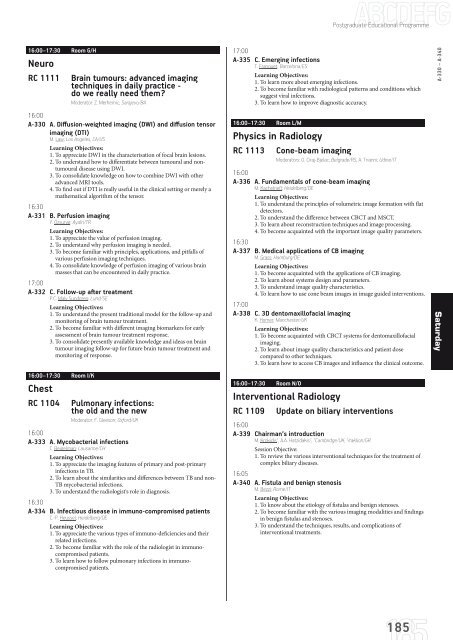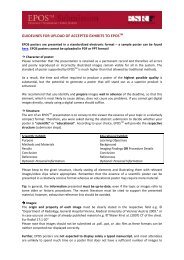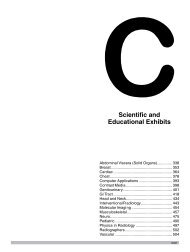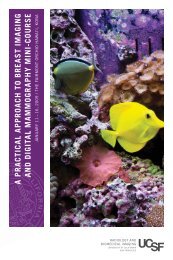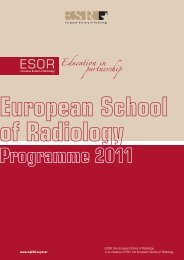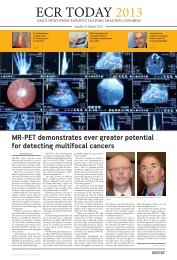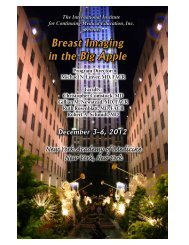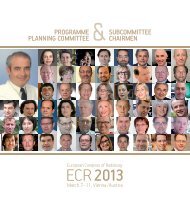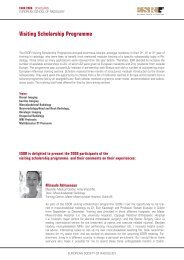ECR 2013 â Final Programme - myESR.org
ECR 2013 â Final Programme - myESR.org
ECR 2013 â Final Programme - myESR.org
- No tags were found...
You also want an ePaper? Increase the reach of your titles
YUMPU automatically turns print PDFs into web optimized ePapers that Google loves.
Postgraduate Educational <strong>Programme</strong>16:00–17:30 Room G/HNeuroRC 1111Brain tumours: advanced imagingtechniques in daily practice -do we really need them?Moderator: Z. Merhemic; Sarajevo/BA16:00A-330 A. Diffusion-weighted imaging (DWI) and diffusion tensorimaging (DTI)M. Law; Los Angeles, CA/USLearning Objectives:1. To appreciate DWI in the characterisation of focal brain lesions.2. To understand how to differentiate between tumoural and nontumouraldisease using DWI.3. To consolidate knowledge on how to combine DWI with otheradvanced MRI tools.4. To find out if DTI is really useful in the clinical setting or merely amathematical algorithm of the tensor.16:30A-331 B. Perfusion imagingY. Özsunar; Aydin/TRLearning Objectives:1. To appreciate the value of perfusion imaging.2. To understand why perfusion imaging is needed.3. To become familiar with principles, applications, and pitfalls ofvarious perfusion imaging techniques.4. To consolidate knowledge of perfusion imaging of various brainmasses that can be encountered in daily practice.17:00A-332 C. Follow-up after treatmentP.C. Maly Sundgren; Lund/SELearning Objectives:1. To understand the present traditional model for the follow-up andmonitoring of brain tumour treatment.2. To become familiar with different imaging biomarkers for earlyassessment of brain tumour treatment response.3. To consolidate presently available knowledge and ideas on braintumour imaging follow-up for future brain tumour treatment andmonitoring of response.16:00–17:30 Room I/KChestRC 1104Pulmonary infections:the old and the newModerator: F. Gleeson; Oxford/UK16:00A-333 A. Mycobacterial infectionsC. Beigelman; Lausanne/CHLearning Objectives:1. To appreciate the imaging features of primary and post-primaryinfections in TB.2. To learn about the similarities and differences between TB and non-TB mycobacterial infections.3. To understand the radiologist‘s role in diagnosis.16:30A-334 B. Infectious disease in immuno-compromised patientsC.-P. Heussel; Heidelberg/DELearning Objectives:1. To appreciate the various types of immuno-deficiencies and theirrelated infections.2. To become familiar with the role of the radiologist in immunocompromisedpatients.3. To learn how to follow pulmonary infections in immunocompromisedpatients.17:00A-335 C. Emerging infectionsT. Franquet; Barcelona/ESLearning Objectives:1. To learn more about emerging infections.2. To become familiar with radiological patterns and conditions whichsuggest viral infections.3. To learn how to improve diagnostic accuracy.16:00–17:30 Room L/MPhysics in RadiologyRC 1113 Cone-beam imagingModerators: O. Ciraj-Bjelac; Belgrade/RS, A. Trianni; Udine/IT16:00A-336 A. Fundamentals of cone-beam imagingM. Kachelrieß; Heidelberg/DELearning Objectives:1. To understand the principles of volumetric image formation with flatdetectors.2. To understand the difference between CBCT and MSCT.3. To learn about reconstruction techniques and image processing.4. To become acquainted with the important image quality parameters.16:30A-337 B. Medical applications of CB imagingM. Grass; Hamburg/DELearning Objectives:1. To become acquainted with the applications of CB imaging.2. To learn about systems design and parameters.3. To understand image quality characteristics.4. To learn how to use cone beam images in image guided interventions.17:00A-338 C. 3D dentomaxillofacial imagingK. Horner; Manchester/UKLearning Objectives:1. To become acquainted with CBCT systems for dentomaxillofacialimaging.2. To learn about image quality characteristics and patient dosecompared to other techniques.3. To learn how to access CB images and influence the clinical outcome.16:00–17:30 Room N/OInterventional RadiologyRC 1109 Update on biliary interventions16:00A-339 Chairman‘s introductionM. Krokidis 1 , A.A. Hatzidakis 2 ; 1 Cambridge/UK, 2 Iraklion/GRSession Objective:1. To review the various interventional techniques for the treatment ofcomplex biliary diseases.16:05A-340 A. Fistula and benign stenosisM. Bezzi; Rome/ITLearning Objectives:1. To know about the etiology of fistulas and benign stenoses.2. To become familiar with the various imaging modalities and findingsin benign fistulas and stenoses.3. To understand the techniques, results, and complications ofinterventional treatments.A-330 – A-340Saturday185


